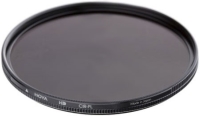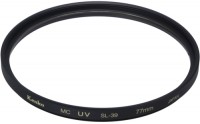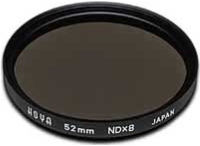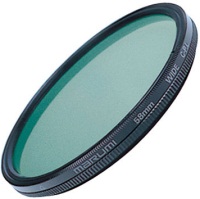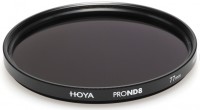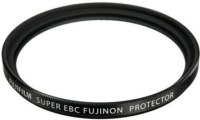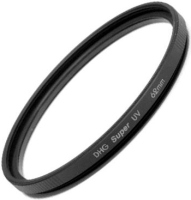Lens Filters Hoya
All Lens Filters Advanced filters → |
You might be interested in
Articles, reviews, useful tips
All materials
Everything is relative: interchangeable lenses for cameras from third-party manufacturers
Lenses from alternative brands: money down the drain or an increase in image quality?

Guide to the main types of filters in photography
Types and methods of application of light filters in the genre of photography
Lens Filters: specifications, types
Size
The diameter of the filter thread for mounting on the lens. Different models of lenses have different dimensions, and accordingly, the sizes of “seats” for light filters also differ. In modern photographic equipment, a set of standard diameters is used, in the range of about 27-82 mm.
Filters per set
The number of filters supplied with the kit. This parameter is specified only for sets consisting of more than one filter — most often three. The most popular combinations in these kits are UV, PO and ND (or macro; see "Type"), or three macro filters with varying degrees of magnification (see below).
Type
The type is a key characteristic of any colour filter: it describes how it works and, accordingly, its application.
— Ultraviolet. The main function of such filters is to trap excess ultraviolet radiation, which reduces the quality of images and adversely affects camera matrices. They are designed primarily for shooting in the mountains or on the coast, where UV levels are higher than normal conditions: UV filters correct colour reproduction, eliminating excess blue, and increase contrast. In other conditions, such filters practically do not affect the quality of images, and therefore can be used as a permanent protection of the lens from moisture and pollution.
— Infrared. In this case, filters are meant that transmit only infrared radiation; shooting in this range requires a special film or a camera with a matrix that is sensitive to IR rays. IR photography is used both for scientific and technical purposes, and in artistic photography, since it allows you to get unusual effects (for example, the leaves of trees in the IR range may look white). In addition, different filters pass different ranges of infrared radiation, which gives even greater features in artistic experiments.
— Colour enhancer. As the name implies, such filters are used to emphasize a certain colour — for this, their glasses are painted in one colour or another. There are v...ariants painted in several colours, they are usually used for various classic situations (for example, blue and green — “sky and grass”, “sky and forest”). In fact, colour enhancers are mainly used in professional colour photography, because you can easily reconfigure colours in a photo within certain limits due to post-processing in a photo editor.
— Colour balancing. A filter designed to change the overall colour balance of an image (this setting is also called “colour temperature”), see “Colour balance” for details. It is used mainly in film photography, because. digital cameras usually have their own colour balance adjustment tools.
— For b/w photo. A type of colour enhancing filter (see above) designed to provide contrast in black and white photographs. One of the peculiarities of b/w photography is that objects that are seen as contrasting in colour can practically merge in black and white images — for example, red berries against a background of green leaves. By applying a colour filter, you can emphasize the desired colour, making it lighter or, conversely, darker in a b/w image: for example, in this example, a green filter will make the leaves light and the berries dark. It is worth noting that, despite the apparent similarity, B/W filters are not intended to be used as colour enhancers in colour shooting, because have their own colour correction specifics (see below) — in particular, they affect the entire spectrum and introduce noticeable distortions in colour reproduction.
— Gradient. Filters with partially shaded or coloured glasses; the other part of the glass is transparent. Shaded (neutral grey) filters are mainly used to equalize the brightness and allow you to correctly convey the contrast in the entire picture if the areas being photographed differ greatly in illumination. This is especially true in landscape photography, where there are often bright skies and relatively dimly lit ground: by setting the gradient filter with the dark side up, you can get a high-quality shot by muting the glow of the sky. Colour gradient filters can be used as colour enhancing filters (see above) or for artistic effects. Often such filters have a design that allows you to change the height of the location relative to the lens.
— Polarized. Light filters equipped with polarized glass. Such glass has a number of properties that are useful primarily for landscape photography, including filming near the water. So, it partially eliminates glare and reflections, which helps to avoid blurring and makes water shots clearer, and the sky in the pictures through the polarizer looks more saturated. In addition, to a certain extent, such filters can even replace neutral ones (see below), because. allow for a longer exposure. Another area of their application is filming through glass (albeit in a certain range of angles).
— Neutral. Such filters have a "neutral" grey tint and are designed to reduce the intensity of the light flux without changing its spectrum. They are useful, for example, if you want to use a slow shutter speed to show movement effectively or an open aperture to blur the background, but the subject is strongly lit, and the sensor or film has too high a sensitivity. The ND filter saves the day by essentially providing a desensitizing effect.
— Softening. The softening reflected in the name of these filters is expressed in a certain blurring of the image. This can be used, for example, in portrait photography to smooth out skin texture, eliminate visible imperfections (blemishes, moles, etc.), and in other types of photography to create artistic effects.
— Protective. Such filters are designed solely to protect the front lens of the lens from moisture, dust and fingerprints. They are absolutely transparent, do not change the properties of the light entering the lens and do not affect the shooting in any way.
— Ray. Beam filters are designed to emphasize light sources: they create visible beams in pictures that radiate from these sources. This is achieved thanks to a special glass coating, with embossed grooves.
— Macro. As the name implies, they are designed for macro photography. Such filters are actually additional lenses that reduce the minimum focal length of the lens and allow you to get as close as possible to the object being shot.
— Coloring. Variety of colour filters; in accordance with the name, are designed to colour the image in one colour or another. At the same time, unlike colour-enhancing filters, they do not just emphasize their colour in the general variety, but completely "clog" all the others with it, and as a result, a picture is obtained in different shades of the same colour. This gives the appropriate features for artistic shooting — for example, you can simulate an alien landscape due to the effect of "ethereal" lighting.
— interference. Filters capable of passing only a certain part of the visible light spectrum. This is achieved due to the fact that their glasses are made from many ultra-thin layers of alternating materials with different refractive indices. The most popular way to use this technology is to create protective light filters that protect the camera from “extra” infrared and ultraviolet radiation: an interference “glass” effectively cuts off the light spectrum at the top and bottom edges, passing only visible light. Technically, an interference filter can also be a “colour” (coloring or colour-enhancing) filter, and such models have a number of advantages over traditional (absorptive) colour filters — in particular, good light transmission and effective suppression of “non-native” colour. However, for a number of reasons (in particular, due to the complexity of production), this option has not received much distribution.
— Foggy. A filter that creates the effect of slightly blurring a picture, for example, to create a romantic atmosphere in a photo. Fogging brightens the vast dark areas of the image and visually "unloads" them.
— Effective. This category includes filters designed to apply specific effects to photos and do not belong to any of the categories described above. The set of such effects is very diverse, it includes, in particular, a vignette (darkening of the edges), colour spots or imitation of strokes of paint, incomplete blurring of the background — a small part of the frame remains sharp, etc. The specific type of effect in each case must be specified separately.
— Ultraviolet. The main function of such filters is to trap excess ultraviolet radiation, which reduces the quality of images and adversely affects camera matrices. They are designed primarily for shooting in the mountains or on the coast, where UV levels are higher than normal conditions: UV filters correct colour reproduction, eliminating excess blue, and increase contrast. In other conditions, such filters practically do not affect the quality of images, and therefore can be used as a permanent protection of the lens from moisture and pollution.
— Infrared. In this case, filters are meant that transmit only infrared radiation; shooting in this range requires a special film or a camera with a matrix that is sensitive to IR rays. IR photography is used both for scientific and technical purposes, and in artistic photography, since it allows you to get unusual effects (for example, the leaves of trees in the IR range may look white). In addition, different filters pass different ranges of infrared radiation, which gives even greater features in artistic experiments.
— Colour enhancer. As the name implies, such filters are used to emphasize a certain colour — for this, their glasses are painted in one colour or another. There are v...ariants painted in several colours, they are usually used for various classic situations (for example, blue and green — “sky and grass”, “sky and forest”). In fact, colour enhancers are mainly used in professional colour photography, because you can easily reconfigure colours in a photo within certain limits due to post-processing in a photo editor.
— Colour balancing. A filter designed to change the overall colour balance of an image (this setting is also called “colour temperature”), see “Colour balance” for details. It is used mainly in film photography, because. digital cameras usually have their own colour balance adjustment tools.
— For b/w photo. A type of colour enhancing filter (see above) designed to provide contrast in black and white photographs. One of the peculiarities of b/w photography is that objects that are seen as contrasting in colour can practically merge in black and white images — for example, red berries against a background of green leaves. By applying a colour filter, you can emphasize the desired colour, making it lighter or, conversely, darker in a b/w image: for example, in this example, a green filter will make the leaves light and the berries dark. It is worth noting that, despite the apparent similarity, B/W filters are not intended to be used as colour enhancers in colour shooting, because have their own colour correction specifics (see below) — in particular, they affect the entire spectrum and introduce noticeable distortions in colour reproduction.
— Gradient. Filters with partially shaded or coloured glasses; the other part of the glass is transparent. Shaded (neutral grey) filters are mainly used to equalize the brightness and allow you to correctly convey the contrast in the entire picture if the areas being photographed differ greatly in illumination. This is especially true in landscape photography, where there are often bright skies and relatively dimly lit ground: by setting the gradient filter with the dark side up, you can get a high-quality shot by muting the glow of the sky. Colour gradient filters can be used as colour enhancing filters (see above) or for artistic effects. Often such filters have a design that allows you to change the height of the location relative to the lens.
— Polarized. Light filters equipped with polarized glass. Such glass has a number of properties that are useful primarily for landscape photography, including filming near the water. So, it partially eliminates glare and reflections, which helps to avoid blurring and makes water shots clearer, and the sky in the pictures through the polarizer looks more saturated. In addition, to a certain extent, such filters can even replace neutral ones (see below), because. allow for a longer exposure. Another area of their application is filming through glass (albeit in a certain range of angles).
— Neutral. Such filters have a "neutral" grey tint and are designed to reduce the intensity of the light flux without changing its spectrum. They are useful, for example, if you want to use a slow shutter speed to show movement effectively or an open aperture to blur the background, but the subject is strongly lit, and the sensor or film has too high a sensitivity. The ND filter saves the day by essentially providing a desensitizing effect.
— Softening. The softening reflected in the name of these filters is expressed in a certain blurring of the image. This can be used, for example, in portrait photography to smooth out skin texture, eliminate visible imperfections (blemishes, moles, etc.), and in other types of photography to create artistic effects.
— Protective. Such filters are designed solely to protect the front lens of the lens from moisture, dust and fingerprints. They are absolutely transparent, do not change the properties of the light entering the lens and do not affect the shooting in any way.
— Ray. Beam filters are designed to emphasize light sources: they create visible beams in pictures that radiate from these sources. This is achieved thanks to a special glass coating, with embossed grooves.
— Macro. As the name implies, they are designed for macro photography. Such filters are actually additional lenses that reduce the minimum focal length of the lens and allow you to get as close as possible to the object being shot.
— Coloring. Variety of colour filters; in accordance with the name, are designed to colour the image in one colour or another. At the same time, unlike colour-enhancing filters, they do not just emphasize their colour in the general variety, but completely "clog" all the others with it, and as a result, a picture is obtained in different shades of the same colour. This gives the appropriate features for artistic shooting — for example, you can simulate an alien landscape due to the effect of "ethereal" lighting.
— interference. Filters capable of passing only a certain part of the visible light spectrum. This is achieved due to the fact that their glasses are made from many ultra-thin layers of alternating materials with different refractive indices. The most popular way to use this technology is to create protective light filters that protect the camera from “extra” infrared and ultraviolet radiation: an interference “glass” effectively cuts off the light spectrum at the top and bottom edges, passing only visible light. Technically, an interference filter can also be a “colour” (coloring or colour-enhancing) filter, and such models have a number of advantages over traditional (absorptive) colour filters — in particular, good light transmission and effective suppression of “non-native” colour. However, for a number of reasons (in particular, due to the complexity of production), this option has not received much distribution.
— Foggy. A filter that creates the effect of slightly blurring a picture, for example, to create a romantic atmosphere in a photo. Fogging brightens the vast dark areas of the image and visually "unloads" them.
— Effective. This category includes filters designed to apply specific effects to photos and do not belong to any of the categories described above. The set of such effects is very diverse, it includes, in particular, a vignette (darkening of the edges), colour spots or imitation of strokes of paint, incomplete blurring of the background — a small part of the frame remains sharp, etc. The specific type of effect in each case must be specified separately.
Wavelength, from
The minimum length of light waves transmitted by the filter.
This characteristic allows you to evaluate the range in which the filter operates. It is indicated only for models used in infrared photography (see "Type"): IR waves have a longer wavelength than visible light waves, so the filter must cut off waves shorter than a certain value. The boundary between visible light and infrared radiation lies approximately at the level of 700 nm, and the “classic of the genre” for IR filters is considered to be a threshold of 715 – 720 nm, this option is recommended for beginner IR photographers. At the same time, there are other options — from 650 nm, which transmits part of the visible spectrum, to 950 nm, which severely limits even the IR range. Using different filters in the same situation, you can achieve different effects on the resulting image. Detailed recommendations on this matter are in special sources.
This characteristic allows you to evaluate the range in which the filter operates. It is indicated only for models used in infrared photography (see "Type"): IR waves have a longer wavelength than visible light waves, so the filter must cut off waves shorter than a certain value. The boundary between visible light and infrared radiation lies approximately at the level of 700 nm, and the “classic of the genre” for IR filters is considered to be a threshold of 715 – 720 nm, this option is recommended for beginner IR photographers. At the same time, there are other options — from 650 nm, which transmits part of the visible spectrum, to 950 nm, which severely limits even the IR range. Using different filters in the same situation, you can achieve different effects on the resulting image. Detailed recommendations on this matter are in special sources.
Magnification factor
This parameter is specified for macro filters(see "Type"). The magnification factor is expressed in diopters (d) and indicates the optical power of the lens (which the filter actually is). The larger the magnification factor, the stronger the filter reduces the minimum focal length and the closer you can place the lens during macro shooting.
Dimming ratio
The dimming ratio indicates how many times the light filter reduces the intensity of the light flux passing through it. Each increase (ND) by 2 times means darkening by 1 exposure stop, respectively, the 4ND light filter attenuates the light flux by 2 exposure stops (x). It turns out 8ND — 3x, 16ND — 4x, 32ND — 5x and so on ... This parameter is important primarily for neutral filters (see "Type"). If after ND there is a large number (for example, 100 or more), it is logical that this is not a step (exposure value). To translate, you need to take the logarithm to the base of two.
Colour correction
In fact, it is the colour in which the filter glass is coloured (and, accordingly, the range of the spectrum that it transmits best). Specified for colour enhancing and filters for b/w photos (see "Type").
Colour balance
The degree of change in colour temperature provided by the colour filter. The colour temperature is expressed in degrees Kelvin (K) and reflects the features of the lighting spectrum: it is the higher, the closer the spectrum is to cold shades (blue, purple). For example, the colour temperature of sunlight is about 4000 K, the temperature of light from the blue sky is 7000 K, the average temperature of natural light is 5500 K. This point is relevant primarily for film photography, because. each film is made based on its own colour temperature, and it is impossible to reconfigure this parameter, unlike digital photography. Filters with colour balance correction allow you to get high-quality pictures in inappropriate lighting: for example, with a filter of +2500 K, you can successfully use "daylight" film at 5500 K in a room lit by lamps with a temperature of about 3000 K. Conversely, reducing filters allow you to shoot at "low temperature" film in natural light. Modern colour filters can provide corrections ranging from several hundred to several thousand K and are used both to ensure adequate colour reproduction and for artistic effects.
Number of beams
The number of rays that a beam light filter creates in an image from light sources. For details, see "Type — Beam".
More features
— Multi-layer enlightenment. Enlightenment is the application of a special film to the glass surface, which improves light transmission by reducing reflections and scattering. With multilayer enlightenment, several such films are applied: firstly, this improves light transmission over the entire spectrum (since one film is designed for a rather narrow wavelength range), and secondly, additional layers (protective, water-repellent, etc.) .P.). In addition, multilayer coating significantly reduces colour distortion.
— Thin frame. Due to the thin frame, the filter takes up little space during installation, which allows you to install several filters on one lens at once. Thus, you can combine their effects as you wish.
— Wide angle. Light filters that can be used on wide-angle lenses. They can have a different design: it can be either a filter in a thin frame (see above), or a large-format glass that is larger than the diameter of the lens and mounted on a frame in the shape of a truncated cone, tapering towards the attachment point. Anyway, the main requirement for such a filter is that it does not restrict the field of view of the lens.
— Protective coating. The presence of a special protective coating on the filter glass, resistant to scratches. The characteristics and features of such a coating vary from manufa...cturer to manufacturer, this point should be clarified in the documentation for specific models.
— Waterproof. Moisture-proof light filters have a special coating — thanks to it, water falling on the glass flows almost immediately, without lingering and leaving small drops, spots, etc. This makes it easier to shoot in the rain and near bodies of water.
— Attachment with adapter. This type of mounting is mainly used for rectangular filters. The adapter consists of a ring for attaching to the lens and a filter holder, which, in turn, is attached to the ring. Actually, the filter plate is installed in the filter holder. This scheme allows you to use several filters of different types with the same adapter, changing them if necessary. And vice versa: adapters with different mounting diameters can be produced for the same filter (see "Diameter"), which allows using the same plate with different optics. At the same time, there is no single standard for filter holder sizes, and adapters are often sold separately from the filters themselves; therefore, when choosing such a system, it is worth making sure that the dimensions match.
— Thin frame. Due to the thin frame, the filter takes up little space during installation, which allows you to install several filters on one lens at once. Thus, you can combine their effects as you wish.
— Wide angle. Light filters that can be used on wide-angle lenses. They can have a different design: it can be either a filter in a thin frame (see above), or a large-format glass that is larger than the diameter of the lens and mounted on a frame in the shape of a truncated cone, tapering towards the attachment point. Anyway, the main requirement for such a filter is that it does not restrict the field of view of the lens.
— Protective coating. The presence of a special protective coating on the filter glass, resistant to scratches. The characteristics and features of such a coating vary from manufa...cturer to manufacturer, this point should be clarified in the documentation for specific models.
— Waterproof. Moisture-proof light filters have a special coating — thanks to it, water falling on the glass flows almost immediately, without lingering and leaving small drops, spots, etc. This makes it easier to shoot in the rain and near bodies of water.
— Attachment with adapter. This type of mounting is mainly used for rectangular filters. The adapter consists of a ring for attaching to the lens and a filter holder, which, in turn, is attached to the ring. Actually, the filter plate is installed in the filter holder. This scheme allows you to use several filters of different types with the same adapter, changing them if necessary. And vice versa: adapters with different mounting diameters can be produced for the same filter (see "Diameter"), which allows using the same plate with different optics. At the same time, there is no single standard for filter holder sizes, and adapters are often sold separately from the filters themselves; therefore, when choosing such a system, it is worth making sure that the dimensions match.

